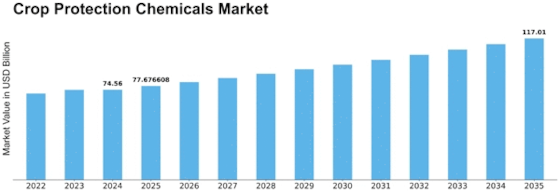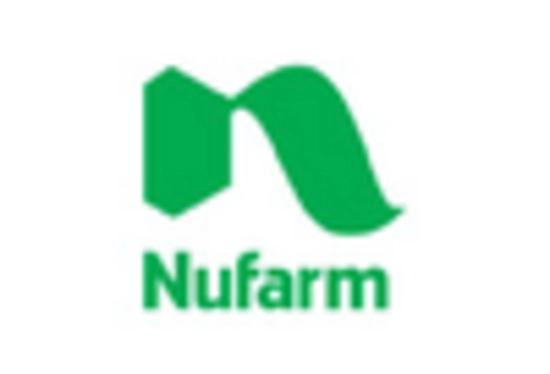Fungicides
Insecticides
Herbicides
Others
Cereal & Grains
Fruits & Vegetables
Oilseed & Pulses
Others
Soil Treatment
Seed Treatment
Foliar Spray
Others
North America
Europe
South America
Asia Pacific
Middle East and Africa
North America Outlook (USD Billion, 2019-2035)
North America Crop Protection Chemicals Market by Type
Fungicides
Insecticides
Herbicides
Others
North America Crop Protection Chemicals Market by Crop Type
Cereal & Grains
Fruits & Vegetables
Oilseed & Pulses
Others
North America Crop Protection Chemicals Market by Mode of Application Type
Soil Treatment
Seed Treatment
Foliar Spray
Others
North America Crop Protection Chemicals Market by Regional Type
US
Canada
US Outlook (USD Billion, 2019-2035)
US Crop Protection Chemicals Market by Type
Fungicides
Insecticides
Herbicides
Others
US Crop Protection Chemicals Market by Crop Type
Cereal & Grains
Fruits & Vegetables
Oilseed & Pulses
Others
US Crop Protection Chemicals Market by Mode of Application Type
Soil Treatment
Seed Treatment
Foliar Spray
Others
CANADA Outlook (USD Billion, 2019-2035)
CANADA Crop Protection Chemicals Market by Type
Fungicides
Insecticides
Herbicides
Others
CANADA Crop Protection Chemicals Market by Crop Type
Cereal & Grains
Fruits & Vegetables
Oilseed & Pulses
Others
CANADA Crop Protection Chemicals Market by Mode of Application Type
Soil Treatment
Seed Treatment
Foliar Spray
Others
Europe Outlook (USD Billion, 2019-2035)
Europe Crop Protection Chemicals Market by Type
Fungicides
Insecticides
Herbicides
Others
Europe Crop Protection Chemicals Market by Crop Type
Cereal & Grains
Fruits & Vegetables
Oilseed & Pulses
Others
Europe Crop Protection Chemicals Market by Mode of Application Type
Soil Treatment
Seed Treatment
Foliar Spray
Others
Europe Crop Protection Chemicals Market by Regional Type
Germany
UK
France
Russia
Italy
Spain
Rest of Europe
GERMANY Outlook (USD Billion, 2019-2035)
GERMANY Crop Protection Chemicals Market by Type
Fungicides
Insecticides
Herbicides
Others
GERMANY Crop Protection Chemicals Market by Crop Type
Cereal & Grains
Fruits & Vegetables
Oilseed & Pulses
Others
GERMANY Crop Protection Chemicals Market by Mode of Application Type
Soil Treatment
Seed Treatment
Foliar Spray
Others
UK Outlook (USD Billion, 2019-2035)
UK Crop Protection Chemicals Market by Type
Fungicides
Insecticides
Herbicides
Others
UK Crop Protection Chemicals Market by Crop Type
Cereal & Grains
Fruits & Vegetables
Oilseed & Pulses
Others
UK Crop Protection Chemicals Market by Mode of Application Type
Soil Treatment
Seed Treatment
Foliar Spray
Others
FRANCE Outlook (USD Billion, 2019-2035)
FRANCE Crop Protection Chemicals Market by Type
Fungicides
Insecticides
Herbicides
Others
FRANCE Crop Protection Chemicals Market by Crop Type
Cereal & Grains
Fruits & Vegetables
Oilseed & Pulses
Others
FRANCE Crop Protection Chemicals Market by Mode of Application Type
Soil Treatment
Seed Treatment
Foliar Spray
Others
RUSSIA Outlook (USD Billion, 2019-2035)
RUSSIA Crop Protection Chemicals Market by Type
Fungicides
Insecticides
Herbicides
Others
RUSSIA Crop Protection Chemicals Market by Crop Type
Cereal & Grains
Fruits & Vegetables
Oilseed & Pulses
Others
RUSSIA Crop Protection Chemicals Market by Mode of Application Type
Soil Treatment
Seed Treatment
Foliar Spray
Others
ITALY Outlook (USD Billion, 2019-2035)
ITALY Crop Protection Chemicals Market by Type
Fungicides
Insecticides
Herbicides
Others
ITALY Crop Protection Chemicals Market by Crop Type
Cereal & Grains
Fruits & Vegetables
Oilseed & Pulses
Others
ITALY Crop Protection Chemicals Market by Mode of Application Type
Soil Treatment
Seed Treatment
Foliar Spray
Others
SPAIN Outlook (USD Billion, 2019-2035)
SPAIN Crop Protection Chemicals Market by Type
Fungicides
Insecticides
Herbicides
Others
SPAIN Crop Protection Chemicals Market by Crop Type
Cereal & Grains
Fruits & Vegetables
Oilseed & Pulses
Others
SPAIN Crop Protection Chemicals Market by Mode of Application Type
Soil Treatment
Seed Treatment
Foliar Spray
Others
REST OF EUROPE Outlook (USD Billion, 2019-2035)
REST OF EUROPE Crop Protection Chemicals Market by Type
Fungicides
Insecticides
Herbicides
Others
REST OF EUROPE Crop Protection Chemicals Market by Crop Type
Cereal & Grains
Fruits & Vegetables
Oilseed & Pulses
Others
REST OF EUROPE Crop Protection Chemicals Market by Mode of Application Type
Soil Treatment
Seed Treatment
Foliar Spray
Others
APAC Outlook (USD Billion, 2019-2035)
APAC Crop Protection Chemicals Market by Type
Fungicides
Insecticides
Herbicides
Others
APAC Crop Protection Chemicals Market by Crop Type
Cereal & Grains
Fruits & Vegetables
Oilseed & Pulses
Others
APAC Crop Protection Chemicals Market by Mode of Application Type
Soil Treatment
Seed Treatment
Foliar Spray
Others
APAC Crop Protection Chemicals Market by Regional Type
China
India
Japan
South Korea
Malaysia
Thailand
Indonesia
Rest of APAC
CHINA Outlook (USD Billion, 2019-2035)
CHINA Crop Protection Chemicals Market by Type
Fungicides
Insecticides
Herbicides
Others
CHINA Crop Protection Chemicals Market by Crop Type
Cereal & Grains
Fruits & Vegetables
Oilseed & Pulses
Others
CHINA Crop Protection Chemicals Market by Mode of Application Type
Soil Treatment
Seed Treatment
Foliar Spray
Others
INDIA Outlook (USD Billion, 2019-2035)
INDIA Crop Protection Chemicals Market by Type
Fungicides
Insecticides
Herbicides
Others
INDIA Crop Protection Chemicals Market by Crop Type
Cereal & Grains
Fruits & Vegetables
Oilseed & Pulses
Others
INDIA Crop Protection Chemicals Market by Mode of Application Type
Soil Treatment
Seed Treatment
Foliar Spray
Others
JAPAN Outlook (USD Billion, 2019-2035)
JAPAN Crop Protection Chemicals Market by Type
Fungicides
Insecticides
Herbicides
Others
JAPAN Crop Protection Chemicals Market by Crop Type
Cereal & Grains
Fruits & Vegetables
Oilseed & Pulses
Others
JAPAN Crop Protection Chemicals Market by Mode of Application Type
Soil Treatment
Seed Treatment
Foliar Spray
Others
SOUTH KOREA Outlook (USD Billion, 2019-2035)
SOUTH KOREA Crop Protection Chemicals Market by Type
Fungicides
Insecticides
Herbicides
Others
SOUTH KOREA Crop Protection Chemicals Market by Crop Type
Cereal & Grains
Fruits & Vegetables
Oilseed & Pulses
Others
SOUTH KOREA Crop Protection Chemicals Market by Mode of Application Type
Soil Treatment
Seed Treatment
Foliar Spray
Others
MALAYSIA Outlook (USD Billion, 2019-2035)
MALAYSIA Crop Protection Chemicals Market by Type
Fungicides
Insecticides
Herbicides
Others
MALAYSIA Crop Protection Chemicals Market by Crop Type
Cereal & Grains
Fruits & Vegetables
Oilseed & Pulses
Others
MALAYSIA Crop Protection Chemicals Market by Mode of Application Type
Soil Treatment
Seed Treatment
Foliar Spray
Others
THAILAND Outlook (USD Billion, 2019-2035)
THAILAND Crop Protection Chemicals Market by Type
Fungicides
Insecticides
Herbicides
Others
THAILAND Crop Protection Chemicals Market by Crop Type
Cereal & Grains
Fruits & Vegetables
Oilseed & Pulses
Others
THAILAND Crop Protection Chemicals Market by Mode of Application Type
Soil Treatment
Seed Treatment
Foliar Spray
Others
INDONESIA Outlook (USD Billion, 2019-2035)
INDONESIA Crop Protection Chemicals Market by Type
Fungicides
Insecticides
Herbicides
Others
INDONESIA Crop Protection Chemicals Market by Crop Type
Cereal & Grains
Fruits & Vegetables
Oilseed & Pulses
Others
INDONESIA Crop Protection Chemicals Market by Mode of Application Type
Soil Treatment
Seed Treatment
Foliar Spray
Others
REST OF APAC Outlook (USD Billion, 2019-2035)
REST OF APAC Crop Protection Chemicals Market by Type
Fungicides
Insecticides
Herbicides
Others
REST OF APAC Crop Protection Chemicals Market by Crop Type
Cereal & Grains
Fruits & Vegetables
Oilseed & Pulses
Others
REST OF APAC Crop Protection Chemicals Market by Mode of Application Type
Soil Treatment
Seed Treatment
Foliar Spray
Others
South America Outlook (USD Billion, 2019-2035)
South America Crop Protection Chemicals Market by Type
Fungicides
Insecticides
Herbicides
Others
South America Crop Protection Chemicals Market by Crop Type
Cereal & Grains
Fruits & Vegetables
Oilseed & Pulses
Others
South America Crop Protection Chemicals Market by Mode of Application Type
Soil Treatment
Seed Treatment
Foliar Spray
Others
South America Crop Protection Chemicals Market by Regional Type
Brazil
Mexico
Argentina
Rest of South America
BRAZIL Outlook (USD Billion, 2019-2035)
BRAZIL Crop Protection Chemicals Market by Type
Fungicides
Insecticides
Herbicides
Others
BRAZIL Crop Protection Chemicals Market by Crop Type
Cereal & Grains
Fruits & Vegetables
Oilseed & Pulses
Others
BRAZIL Crop Protection Chemicals Market by Mode of Application Type
Soil Treatment
Seed Treatment
Foliar Spray
Others
MEXICO Outlook (USD Billion, 2019-2035)
MEXICO Crop Protection Chemicals Market by Type
Fungicides
Insecticides
Herbicides
Others
MEXICO Crop Protection Chemicals Market by Crop Type
Cereal & Grains
Fruits & Vegetables
Oilseed & Pulses
Others
MEXICO Crop Protection Chemicals Market by Mode of Application Type
Soil Treatment
Seed Treatment
Foliar Spray
Others
ARGENTINA Outlook (USD Billion, 2019-2035)
ARGENTINA Crop Protection Chemicals Market by Type
Fungicides
Insecticides
Herbicides
Others
ARGENTINA Crop Protection Chemicals Market by Crop Type
Cereal & Grains
Fruits & Vegetables
Oilseed & Pulses
Others
ARGENTINA Crop Protection Chemicals Market by Mode of Application Type
Soil Treatment
Seed Treatment
Foliar Spray
Others
REST OF SOUTH AMERICA Outlook (USD Billion, 2019-2035)
REST OF SOUTH AMERICA Crop Protection Chemicals Market by Type
Fungicides
Insecticides
Herbicides
Others
REST OF SOUTH AMERICA Crop Protection Chemicals Market by Crop Type
Cereal & Grains
Fruits & Vegetables
Oilseed & Pulses
Others
REST OF SOUTH AMERICA Crop Protection Chemicals Market by Mode of Application Type
Soil Treatment
Seed Treatment
Foliar Spray
Others
MEA Outlook (USD Billion, 2019-2035)
MEA Crop Protection Chemicals Market by Type
Fungicides
Insecticides
Herbicides
Others
MEA Crop Protection Chemicals Market by Crop Type
Cereal & Grains
Fruits & Vegetables
Oilseed & Pulses
Others
MEA Crop Protection Chemicals Market by Mode of Application Type
Soil Treatment
Seed Treatment
Foliar Spray
Others
MEA Crop Protection Chemicals Market by Regional Type
GCC Countries
South Africa
Rest of MEA
GCC COUNTRIES Outlook (USD Billion, 2019-2035)
GCC COUNTRIES Crop Protection Chemicals Market by Type
Fungicides
Insecticides
Herbicides
Others
GCC COUNTRIES Crop Protection Chemicals Market by Crop Type
Cereal & Grains
Fruits & Vegetables
Oilseed & Pulses
Others
GCC COUNTRIES Crop Protection Chemicals Market by Mode of Application Type
Soil Treatment
Seed Treatment
Foliar Spray
Others
SOUTH AFRICA Outlook (USD Billion, 2019-2035)
SOUTH AFRICA Crop Protection Chemicals Market by Type
Fungicides
Insecticides
Herbicides
Others
SOUTH AFRICA Crop Protection Chemicals Market by Crop Type
Cereal & Grains
Fruits & Vegetables
Oilseed & Pulses
Others
SOUTH AFRICA Crop Protection Chemicals Market by Mode of Application Type
Soil Treatment
Seed Treatment
Foliar Spray
Others
REST OF MEA Outlook (USD Billion, 2019-2035)
REST OF MEA Crop Protection Chemicals Market by Type
Fungicides
Insecticides
Herbicides
Others
REST OF MEA Crop Protection Chemicals Market by Crop Type
Cereal & Grains
Fruits & Vegetables
Oilseed & Pulses
Others
REST OF MEA Crop Protection Chemicals Market by Mode of Application Type
Soil Treatment
Seed Treatment
Foliar Spray
Others


















Leave a Comment